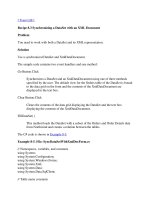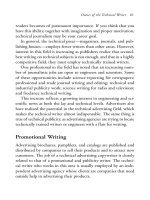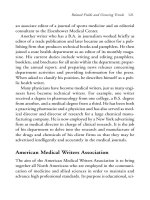Tài liệu Nutrition in Children with Chronic Kidney Disease pptx
Bạn đang xem bản rút gọn của tài liệu. Xem và tải ngay bản đầy đủ của tài liệu tại đây (534.59 KB, 7 trang )
National Institute of Diabetes and Digestive and Kidney Diseases
NATIONAL INSTITUTES OF HEALTH
Nutrition in Children with
Chronic Kidney Disease
Introduction
E
very child needs good nutrition.
If your child has been diagnosed
with kidney disease, learning
about nutrition is vital because your
child’s diet can affect how well the kid-
neys work. Always consult with your
child’s health care team before making
any major changes in your child’s diet.
Our kidneys do many things to help
maintain our health. To keep the body
working properly, the kidneys remove
wastes and extra water from the blood.
They balance the salts—made of sodium,
potassium, calcium, and phosphorus—
that circulate in the blood. And they
control the release of natural chemicals
called hormones that help make red
blood cells, control blood pressure,
and keep bones strong.
In the early stages of chronic kidney
disease (CKD), the kidneys continue to
work. They just don’t do their job as
well as normal kidneys do. Since the
decline in kidney function happens slow-
ly, your child’s body may adapt, and you
may not notice any change in the way
your child looks or feels. Unfortunately,
over time, small changes can build up,
and as the kidney disease worsens (CKD
stages 4 and 5), your child may develop
more symptoms of kidney disease.
As kidney disease progresses, nutritional
needs change as well. When the kid-
neys don’t work normally, your child’s
health care team may recommend a
change in your child’s diet to protect
the kidneys. Health problems from
CKD can be prevented or delayed by
eating the right foods.
Kidney disease can limit a child’s
growth. Your child’s health care team
will work with you to make sure that
your child’s growth is as normal as pos-
sible. As children grow, their nutritional
needs change as well. Work with your
child’s health care team to be certain
your child gets the right amount of all
necessary nutrients. At different times,
the team may suggest changes in both
the amount and the types of food your
child needs to eat. Learning about food
choices will help you understand what
changes need to be made to ensure that
your child is as healthy as possible.
Energy
Everyone needs energy to grow and
be active. We measure the amount of
energy in the diet by counting calories.
Ta king in too little energy can lead to
decreased activity, poor growth, and
decreased resistance to infection. As
your child grows, energy needs change
depending on age, height, and weight.
Work with the health care team to
determine your child’s daily calorie
needs. If your child is not growing as
well as possible, your child’s health care
team can provide appropriate ways to
add calories to your child’s diet.
U.S. Department of Health
and Human Services
National Institute of Diabetes and Digestive and Kidney Diseases
NATIONAL INSTITUTES OF HEALTH
Treatment Methods for
Kidney Failure in Children
K
idneys play an important part in
achild’s growth and health.
They
remove wastes and extra water from
the blood
regulate blood pressure
balance chemicals like sodium and
potassium
make a hormone that signals bone
marrow to make red blood cells
make a hormone to help bones grow
and keep them strong
Kidney failure can lead directly to more
health problems, like swelling of the
body, bone deformities, and growth fail-
ure. A successful kidney transplant can
give a child with chronic kidney failure
the best chance to grow normally and
lead a full, active life. Dialysis can help
a child to survive an acute episode of
kidney failure or to stay healthy until a
donated kidney becomes available.
Families caring for a child with kidney
disease often need help—not just from
doctors and nurses, but from a whole
team of pediatric specialists, including
dietitians, social workers, and family
counselors. Learning about treatments
for kidney disease and getting to know
the entire team can make life easier for
your child and your entire family.
Problems Specific to Children
Everyone who has kidney failure, adults
and children alike, will experience med-
ical complications, which may include
extreme fatigue, inability to concen-
trate, weak bones, nerve damage,
depression, and sleep problems. Addi-
tional problems for children can include
U.S. Department of Health
and Human Services
The kidneys remove wastes and extra water from the
blood to form urine. Urine flows from the kidneys to
the bladder through the ureters.
Kidneys
Bladder
Ureters
Phone: 800.633.6628 • www.kidneyurology.org
Health care professionals calculate a child’s
daily energy needs using the child’s weight as
part of the equation. For example, a 3-month-
old baby requires 49 calories a day for each
pound of her body weight. If the baby weighs
8 pounds, she would need 392 calories per day.
8
×
49 = 392
As the baby gains weight, she requires more
calories. If she gains 2 pounds, her daily
calorie requirement would increase to 490.
10
×
49 = 490
The following chart shows how energy needs
change as a child grows. A growing child
requires more and more energy, or calories.
But the older child does not need as many
calories per pound of body weight as an
infant needs.
Energy needs will vary and you should discuss
any changing needs with your child’s health
care team.
Protein
Protein is an essential part of any diet. It helps
build and maintain muscle, bone, skin, organs,
and blood. Some proteins help fight disease
and heal wounds. All proteins break down
into waste products that must be cleaned from
the blood by the kidneys.
Doctors sometimes recommend that patients
with CKD eat moderate or reduced amounts
of protein. In some patients, however,
restricting protein can prevent adequate
growth and may lead to malnutrition. For
children with kidney disease, the goal is to eat
enough protein for growth but to stay away
from high protein intake. If your child is
on dialysis, your child’s protein needs will
increase, but the amount of this increase will
be based on the type and frequency of dialysis.
Talk with your child’s health care team about
the amount of protein and the sources of pro-
tein in your child’s diet. Animal sources such
as eggs, milk, cheese, chicken, fish, and red
meats contain more of the essential amino
acids the body needs. A well-balanced vege-
tarian meal plan can also provide these nutri-
ents. Your child’s health care team can suggest
ways to make adjustments in eating habits
to help meet your child’s protein needs. The
following table has examples of the protein
content of some common foods, but your
child’s health care team can customize the
list to your family’s diet habits.
2
Energy Needs for Children with
Kidney Disease
Age Range Calories / Pound / Day
Infant 0–6 months 49
7–12 months 45
Toddler 1–3 years 46
Child 4–6 years 41
7–10 years 32
Adolescents Girls Boys
11–14 years 21 25
15–18 years 18 20
Source: United States Department of Agriculture (USDA)
National Nutrient Database for Standard Reference, Release
16–1 (www.nal.usda.gov/fnic/foodcomp/Data/SR16-1/wtrank/
16-1w203.pdf; accessed October 13, 2005)
Here is a table with the typical protein needs
for growing children with kidney disease. A
child on hemodialysis needs more protein than
a child who has not started dialysis because
the dialysis process removes protein from the
child’s blood. Peritoneal dialysis removes even
more protein than hemodialysis.
For example, a 10-year-old boy who weighs
60 pounds would need 27 grams of protein a
day before starting dialysis.
60
×
0.45 = 27
Limiting a child to this amount may be difficult
because some foods contain that much protein
in a single serving. You may need to cut sand-
wiches in half or serve smaller portions of
soups and vegetables.
If this same boy started hemodialysis, his daily
protein needs would increase to 36 grams.
60
×
0.6 = 36
On peritoneal dialysis, the boy would need 48
grams of protein a day.
60
×
0.8 = 48
Your child’s protein needs may vary—discuss
them with your child’s health care team.
3
Protein Content of Foods
Food Serving Size
Turkey breast 41 grams/cup
Large hamburger with
vegetables and condiments
34 grams/8-oz sandwich
Tuna sub 30 grams/6-inch sub
Cottage cheese 26 grams/cup
Chili con carne 24 grams/cup
Cold-cut sub 21 grams/6-inch sub
Fast food taco 20 grams/6-oz taco
Fish sandwich with tartar sauce
and cheese
20 grams/6.5-oz sandwich
Baked beans 17 grams/cup
Chicken nuggets 16 grams/6 nuggets
Yogurt 13 grams/8-oz container
Beef stew 12 grams/cup
Fast food burrito with meat and
beans
11 grams/4-oz burrito
Cooked peas 8 grams/cup
Chicken noodle soup 6 grams/cup
Protein Needs for Children
with Kidney Disease
Age Range
Grams / Pound / Day
Pre-
Dialysis
Hemo-
dialysis
Peritoneal
Dialysis
Infant 0–6 months 1 1.2 1.3–1.4
7–12 months 0.73 1.1 1.0–1.1
Toddler 1–3 years 0.5 0.7 0.9
Child 4–6 years 0.5 0.7 0.9
7–10 years 0.45 0.6 0.8
Adolescents 11–14 years 0.45 0.6 0.8
15–18 years 0.4
Girls Boys
0.6–0.7
0.5 0.6
Sodium
Sodium is a mineral that is important for many
body functions. Sodium is found in ordinary
table salt and many seasonings like soy and
teriyaki sauces. One teaspoon of table salt
contains 2,300 milligrams of sodium. Canned
foods, some frozen foods, and most processed
foods have large amounts of table salt. Some
snack foods like chips and crackers are also
high in salt. Too much sodium can increase
thirst, raise blood pressure, and cause water
retention that may lead to excess weight gain
or fluid buildup in the lungs. On the other
hand, in some patients, too little sodium can
lead to dehydration and poor weight gain.
Figuring out how much sodium your child
needs is complicated by the kind of kidney
problem your child has, your child’s age, and
sometimes other factors. Depending on your
child’s own special needs, your health care
team may ask you to either limit or add
sodium to your child’s diet.
Talk with your child’s health care team about
how much sodium your child needs. Look
at the sodium content on the nutrition labels
of the foods you buy. Choose “sodium-free”
or “low-sodium” food products if you need
to reduce sodium in your child’s diet. Nearly
all fresh vegetables and fresh, unprocessed
meat are preferable to processed foods. Try
alternative seasonings like lemon juice or hot
pepper sauce. But avoid salt substitutes that
use potassium.
Source: American Dietetic Association, Complete Food and
Nutrition Guide, RL Duyff, 1998.
4
Sodium Claims on Food Labels
Claim Explanation
“Sodium-free” Less than 5 mg sodium per serving
“Salt-free” Meets requirements for “sodium-free”
“Low-sodium” 140 mg sodium or less per serving
“Very low sodium” 35 mg sodium or less per serving
“Reduced sodium” At least 25 percent less sodium when
compared with the regular version
“Light in sodium” 50 percent less sodium per serving;
restricted to foods with more than
40 calories per serving
“Unsalted, no
added salt”
No salt is added during processing; the
product it resembles and substitutes
for is normally processed with salt;
the label bears the statement “not a
sodium-free food” or “not for control
of sodium in the diet”
Potassium
Potassium is a mineral found in many fruits and
vegetables like bananas, potatoes, avocados,
and melons. It keeps the heart beating regu-
larly and muscles working right. Your child’s
health care team will routinely check your
child’s blood tests to make sure that the potas-
sium level stays in the normal range. If your
child’s potassium begins to rise, talk with your
child’s health care team about ways to limit
the amount of potassium in your child’s diet.
Your child may need to avoid some fruits and
vegetables. The number and portion sizes of
fruits and vegetables may need to be reduced
as well. You can reduce the potassium content
of potatoes and beans by soaking them in
water for several hours before cooking.
Source: United States Department of Agriculture (USDA)
National Nutrient Database for Standard Reference, Release
17–1 (www.nal.usda.gov/fnic/foodcomp/Data/SR17/wtrank/
sr17a306.pdf; accessed October 13, 2005)
Phosphorus
Phosphorus is a mineral found in many foods,
particularly those high in protein. When your
child’s blood phosphorus level is too high, it
pulls calcium from the bones, making them
weaker and more likely to break. Too much
phosphorus may also make your child’s skin
itch and cause redness of the eyes. High pro-
tein foods such as dairy products, meat, dried
beans, peas, colas, nuts, and peanut butter are
high in phosphorus. Talk with your child’s
health care team about how much phosphorus
your child should have in his or her diet.
As kidney disease progresses, it may be nec-
essary to take a phosphate binder with meals
such as calcium acetate (PhosLo), calcium
carbonate (Caltrate, Children’s Maalox tablets,
Oscal, Tums), or sevalemer hydrochloride
(Renagel) to lower the concentration of phos-
phorus in the blood. These medications act
like sponges to soak up, or bind, phosphorus
while it is in the stomach. Because it is bound,
not all of the phosphorus gets into the blood.
Instead, some of it is passed out of the body
in the stool.
Source: United States Department of Agriculture (USDA)
National Nutrient Database for Standard Reference, Release
17–1 (www.nal.usda.gov/fnic/foodcomp/Data/SR17/wtrank/
sr17a305.pdf; accessed October 13, 2005)
5
Potassium Content of Foods
High-Potassium Foods
Lower-Potassium
Alternatives
Oranges and orange juice
Melons
Apricots
Banana
Kiwi
Potatoes
Tomatoes
Sweet potatoes
Cooked spinach
Beans (baked, kidney, lima,
pinto)
Apples and apple juice
Cranberry juice
Canned fruit
Strawberries, blueberries,
raspberries
Plums
Pineapple
Cabbage
Cauliflower
Mustard greens
Broccoli
Phosphorus Content of Foods
High-Phosphorus Foods
Lower-Phosphorus
Alternatives
Dairy foods (milk, cheese,
yogurt)
Beans (baked, kidney, lima,
pinto)
Nuts and peanut butter
Processed meats (hot dogs,
canned meat)
Cola
Canned iced teas and lemonade
Bran cereals
Egg yolks
Liquid non-dairy creamer
Sorbet
Pasta, rice
Rice and corn cereals
Popcorn
Green beans
Lemon-lime soda
Root beer
Powdered iced tea and
lemonade mixes
Fluids
Early in kidney disease, your child’s damaged
kidneys may produce either more or less urine
than normal. If your child makes only a small
amount of urine, swelling or high blood pres-
sure may develop. If the kidneys produce too
much urine, your child is at risk of dehydra-
tion. Tell your child’s health care team if you
notice that your child is making either more or
less urine or if you notice any swelling in the
face, legs, arms, or abdomen.
Once your child’s kidneys fail and your child
begins dialysis, you may need to limit how
much your child drinks. The amount people
drink is often related to the amount of sodium
they eat. If thirst is a problem, you need to
speak with your child’s health care team about
ways to control excess thirst.
Special Problems in the First Year
of Life
Because infants grow so quickly, your child’s
health care team will need to follow your child
more closely during this critical time. Often a
child will need special formulas with extra
supplements (calorie enhancers) to be sure that
your child gets the right amount of fluid and
nutrients. Sometimes an infant can’t drink the
amount of formula he needs to grow, and your
physician may suggest that he be fed by tube.
While this may sound drastic, experience has
shown that tube feeding is often the best way
to be sure that your child gets the full supply
of fluid and nutrients he needs to promote
growth and development. While feeding
tubes are most often used in infants, there are
situations when older children and adolescents
benefit from them as well.
Keep Track of Test Results
If your child has CKD, your child’s health care
team will order regular blood tests. Many
patients find that keeping track of test results
helps them see how well they are doing. Ask
your child’s doctor for copies of the labora-
tory reports and ask to have them explained.
Note any results that are out of the normal
range. When you learn how to read your
child’s reports, you will see how the foods
your child eats can affect laboratory results.
Talk with your child’s health care team about
making healthier food choices. You may ask
for a laboratory report card from your child’s
health care team on a regular basis.
6
The U.S. Government does not endorse or favor
any specific commercial product or company.
Trade, proprietary, or company names appearing
in this document are used only because they are
considered necessary in the context of the
information provided. If a product is not
mentioned, the omission does not mean or
imply that the product is unsatisfactory.
About the Nutrition for
Chronic Kidney Disease Series
The NIDDK Nutrition for Chronic
Kidney Disease Series includes three
fact sheets:
■ Nutrition for Early Chronic Kidney
Disease in Adults
■ Nutrition for Later Chronic Kidney
Disease in Adults
■ Nutrition in Children with Chronic
Kidney Disease
For free single printed copies of this
series, please contact the National Kid-
ney and Urologic Diseases Information
Clearinghouse.
U.S. DEPARTMENT OF HEALTH
AND HUMAN SERVICES
National Institutes of Health
NIH Publication No. 06–5752
March 2006
National Kidney and Urologic
Diseases Information Clearinghouse
3 Information Way
Bethesda, MD 20892–3580
P
hone: 1–800–891–5390
Fax: 703–738–4929
Email:
Internet: www.kidney.niddk.nih.gov
The National Kidney and Urologic Diseases
Information Clearinghouse (NKUDIC) is a
service of the National Institute of Diabetes
and Digestive and Kidney Diseases (NIDDK).
The NIDDK is part of the National Institutes
of Health under the U.S. Department of Health
and Human Services. Established in 1987,
the Clearinghouse provides information about
diseases of the kidneys and urologic system to
people with kidney and urologic disorders and
to their families, health care professionals, and
the public. The NKUDIC answers inquiries,
develops and distributes publications, and
works closely with professional and patient
organizations and Government agencies to
coordinate resources about kidney and
urologic diseases.
Publications produced by the Clearinghouse are
carefully reviewed by both NIDDK scientists
and outside experts. The NKUDIC would like
to thank Joseph Flynn, M.D., of the American
Society of Pediatric Nephrology (ASPN), for
coordinating the review of this fact sheet by the
ASPN’s Clinical Affairs Committee: Barbara
Fivush, M.D. (co-chair), Steve Wassner, M.D.
(co-chair), John Brandt, M.D., Deepa Chand,
M.D., Ira Davis, M.D., Stuart Goldstein, M.D.,
Ann Guillot, M.D., Deborah Kees-Folts, M.D.,
Juan Kupferman, M.D., Gary Lerner, M.D., Tej
Mattoo, M.D., Alicia Neu, M.D., Cynthia Pan,
M.D., William Primack, M.D., and Michael
Somers, M.D.
This publication is not copyrighted. The
Clearinghouse encourages users of this fact
sheet to duplicate and distribute as many
copies as desired.
This fact sheet is also available at
www.kidney.niddk.nih.gov.
About the Nutrition for
Chronic Kidney Disease Series
The NIDDK Nutrition for Chronic
Kidney Disease Series includes three
fact sheets:
■ Nutrition for Early Chronic Kidney
Disease in Adults
■ Nutrition for Later Chronic Kidney
Disease in Adults
■ Nutrition in Children with Chronic
Kidney Disease
For free single printed copies of this
series, please contact the National Kid-
ney and Urologic Diseases Information
Clearinghouse.
T
he U.S. Government does not endorse or favor
any specific commercial product or company.
Trade, proprietary, or company names appearing
in this document are used only because they are
considered necessary in the context of the
information provided. If a product is not
mentioned, the omission does not mean or
imply that the product is unsatisfactory.
For More Information
A









